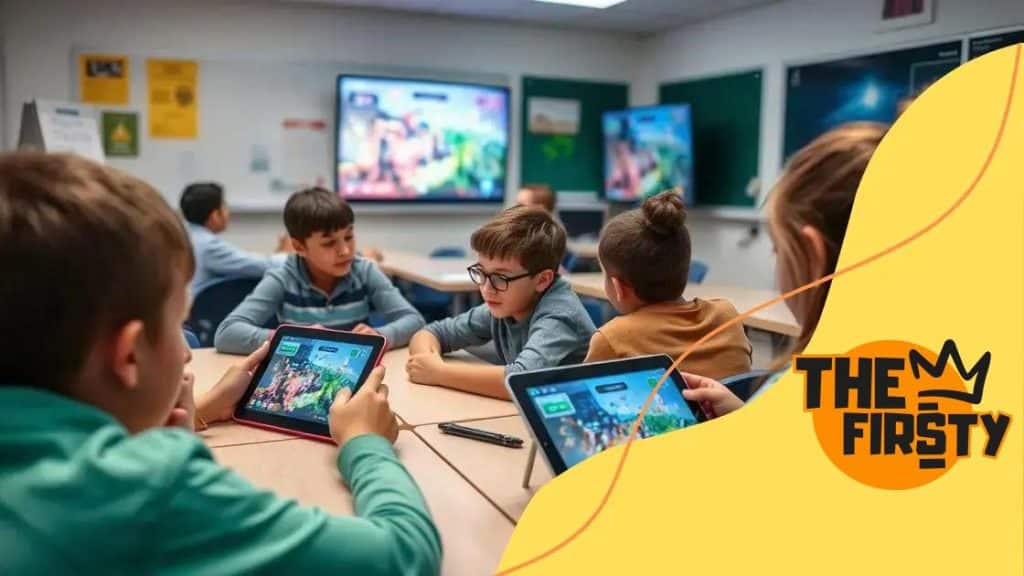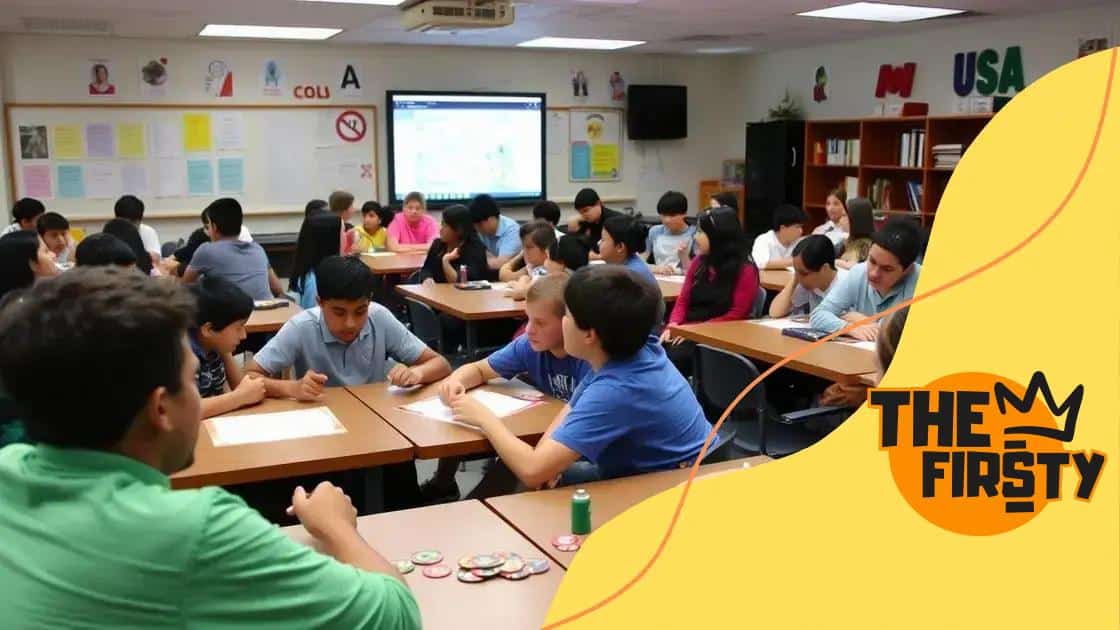Gamification’s role in increasing student engagement

Anúncios
Gamification’s role in increasing student engagement involves using game elements to enhance motivation, participation, and learning outcomes, transforming traditional educational experiences into interactive and enjoyable activities.
Gamification’s role in increasing student engagement is becoming an essential strategy in modern education. Have you ever wondered how games can make learning more fun and interactive? Let’s dive into how these techniques can captivate students and boost their enthusiasm for learning.
Anúncios
Understanding gamification in education
Understanding gamification in education is key to making learning exciting and effective. By integrating game elements, educators can motivate students to engage more deeply with their studies. This approach transforms the traditional learning atmosphere into a playful and interactive experience.
What Is Gamification?
Gamification is the application of game-design elements in non-game contexts. In education, this means using rewards, challenges, and competitions to enhance student participation. Students can earn points or badges, competing with themselves or their peers to reach goals.
Benefits of Gamification
- Increased Engagement: By making learning fun, students are naturally drawn to participate.
- Enhanced Motivation: The reward system keeps students motivated to strive for success.
- Improved Retention: Gamified learning helps students remember information better.
When students are actively participating and enjoying the learning process, the content sticks better. Gamification can also encourage collaboration among students, fostering teamwork and communication skills. For instance, in a classroom where points are awarded for group projects, students work together, learn from each other, and build on their strengths.
Anúncios
Another essential aspect of gamification is instant feedback. Using quizzes and interactive activities, students get immediate responses, allowing them to adjust their learning strategies on the spot. This feedback loop is crucial for mastering subjects effectively.
Challenges in Understanding Gamification
While the benefits are significant, understanding how to implement gamification effectively can be challenging. Some educators may struggle with the technology involved or might not know how to integrate game elements meaningfully into their lesson plans. It’s important to find a balance so that the game aspect does not overshadow the educational intention.
Moreover, not every student responds to gamified learning similarly. Some may find it distracting or overwhelming, which is why it’s essential to tailor gamification strategies to meet the needs of all learners. Engaging all students in this way can create a more diverse learning environment where everyone has a chance to shine.
Overall, understanding gamification in education opens new doors in teaching methodologies, making learning a more interactive and enjoyable experience for students of all ages.
The psychological impact of gamification
The psychological impact of gamification is profound and transformative in educational settings. By introducing game elements, educators can harness motivation and enhance learning experiences. Students who engage with gamified activities often feel a greater sense of accomplishment and ownership over their learning.
Motivation and Engagement
One of the most significant benefits of gamification is its ability to boost motivation. When students see immediate rewards, such as points or badges, they are more likely to remain engaged in their tasks. This sense of achievement can lead to continuous participation, where students are eager to explore new challenges.
Social Interaction
Gamification also fosters social interaction among students. Through collaborative games and challenges, learners develop connections with their peers. This not only promotes teamwork but also contributes to a supportive learning environment. For instance, team-based challenges encourage students to communicate effectively and share their skills.
- Sense of Community: Students feel they belong to a group.
- Peer Support: Students help each other achieve goals.
- Improved Communication: Collaboration enhances verbal and non-verbal skills.
Moreover, gamification can reduce anxiety in educational settings. Traditional assessments might cause stress, but gamified assessments transform the evaluation process into a fun activity. This shift helps students approach their learning without fear of failure, allowing them to experiment and explore concepts more freely.
Another intriguing aspect of the psychological impact is how gamification promotes problem-solving skills. Game-based learning environments often require students to think critically and develop strategies to overcome obstacles. By navigating through challenges, they enhance their ability to analyze situations and make informed decisions.
Long-term Effects
In the long run, the psychological benefits of gamification can extend beyond the classroom. Students who experience enjoyable learning environments are more likely to develop a lifelong love for learning. This foundation sets the stage for future academic and personal success, as they become curious, self-driven individuals.
Understanding the psychological impact of gamification allows educators to create more engaging and effective learning experiences. By leveraging motivation, social interaction, and critical thinking, gamification reshapes how students view education.
Practical examples of gamification

Practical examples of gamification showcase how effective this approach can be in real educational settings. Educators around the world have successfully implemented gamified strategies to motivate students and enhance their learning experiences. These examples can illustrate the diverse ways that gamification can engage learners.
Classroom Games
One common example is classroom games where lessons are turned into fun challenges. For instance, educators may use quiz games where students compete in teams to answer questions correctly. This not only reinforces the material but also cultivates a competitive spirit that spurs students to study harder. By incorporating leaderboards, students stay invested in their progress and strive to improve their rankings.
Badges and Rewards
Another effective method is the use of badges and rewards. When students complete assignments or master new skills, they earn badges that they can display. This creates a sense of accomplishment and encourages them to pursue additional goals.
- Digital Badges: Reward students for completing tasks.
- Point Systems: Foster competition by allowing students to accumulate points for achievements.
- Praise and Recognition: Public acknowledgment of achievements boosts self-esteem.
By engaging in these activities, students feel a greater connection to their learning. Furthermore, many educators use gamified platforms like Kahoot! and Classcraft, which offer ready-made gamified materials that can be easily integrated into existing curricula.
Project-based learning is another example where gamification shines. In this model, students embark on quests or missions that require them to research and develop projects related to specific topics. Throughout their projects, they might face various challenges that require critical thinking and teamwork. As they progress, they earn points or rewards that recognize their efforts.
Simulation and Role-Playing
Simulation games and role-playing are powerful tools in gamified education. For example, students in a history class may participate in a simulation of a historical event, role-playing as key figures from that period. This immersive experience helps them understand complex topics and enhances emotional engagement.
By blending gaming with education, practical examples of gamification offer dynamic opportunities for students to learn. Each of these strategies emphasizes active participation and collaboration, fostering a sense of community in classrooms.
Measuring engagement through gamified tools
Measuring engagement through gamified tools is essential for understanding how effective these strategies are in real educational settings. Educators use various tools to track students’ progress and assess their participation. These tools help in identifying what works well and what needs improvement.
Data Tracking Tools
Many gamified platforms offer powerful data tracking tools that provide insight into student engagement. For example, platforms like Classcraft and Kahoot! collect data about student performance and participation levels. This data can guide teachers in making informed decisions about their teaching methods.
Using these analytics, educators can see which activities keep students interested and which may need to be adjusted. This feedback loop is crucial for enhancing the overall learning experience.
Surveys and Feedback
In addition to data analytics, surveys and feedback tools can measure student engagement effectively. After participating in gamified activities, students can be asked to provide feedback on their experiences. Questions can include how much they enjoyed the game, whether they felt motivated, and if they learned something new.
- Engagement Survey: Gather insights on student enjoyment.
- Learning Outcome Feedback: Assess if students learned concepts effectively.
- Suggestions for Improvement: Allow students to suggest how games could be improved.
This qualitative data helps educators understand students’ perspectives and improves future gamification efforts.
Another method of measuring engagement is observing classroom dynamics during gamified activities. Teachers can note how actively students participate and interact with each other. For instance, high levels of collaboration and excitement indicate strong engagement and effectiveness of the gamified tools being used.
Regular Assessment
Regular assessments also play a crucial role. Incorporating quizzes, challenges, and competitions at the end of each module can show how well students have absorbed the material. These assessments can take the form of games themselves, reinforcing the gamification concept while measuring knowledge retention.
The key to measuring engagement through gamified tools is continuous evaluation. Regularly analyzing the gathered data allows teachers to refine their approaches and keep students motivated and engaged throughout the learning process.
Challenges in implementing gamification
Challenges in implementing gamification can arise in various educational settings. While gamification has many benefits, educators often face obstacles that can hinder its effectiveness. Understanding these challenges is crucial for successful integration into curricula.
Technological Barriers
One major challenge is technological barriers. Not all schools have access to the necessary technology, such as computers or tablets, which can limit the implementation of gamified learning tools. Additionally, educators may lack training in using these technologies effectively. This can create a gap where some students may not benefit from gamification as others do.
Resistance to Change
Another challenge is resistance to change. Some educators may be hesitant to adopt gamification because they are accustomed to traditional teaching methods. They may feel uncertain about how to incorporate game elements into their lessons or worry that these methods may not align with academic standards. Overcoming this resistance requires strong leadership and support from school administrations.
- Training and Workshops: Providing professional development can help educators feel more comfortable.
- Clear Guidelines: Establishing best practices for gamification can alleviate concerns.
- Supportive Environment: Encouraging collaboration among teachers can foster creativity and innovation.
Moreover, understanding student diversity is crucial in overcoming these challenges. Not all students respond the same way to gamification. Some may thrive in competitive environments, while others may feel anxious or disengaged. Teachers need to create an inclusive atmosphere where all students can benefit from gamified activities.
Assessment Difficulties
Assessment can also pose a challenge. Evaluating the effectiveness of gamification methods is not always straightforward. Teachers may find it difficult to measure learning outcomes accurately when using gamified tools. This can lead to confusion about whether students are truly learning or just enjoying the game aspects.
To address this, educators should develop clear criteria for assessing both engagement and learning outcomes. This can ensure that gamified learning is making a positive impact on students’ educational experiences.
Ultimately, while challenges exist in implementing gamification, recognizing and addressing these issues can lead to more effective and engaging learning environments. Collaboration, training, and a willingness to adapt are key to overcoming these obstacles and unlocking the full potential of gamified education.
FAQ – Frequently Asked Questions about Gamification in Education
What is gamification in education?
Gamification in education involves using game elements to enhance learning and engagement, making lessons more interactive and enjoyable.
How can gamification improve student motivation?
Gamification boosts student motivation by providing rewards, challenges, and a competitive atmosphere, encouraging students to participate actively.
What are some common challenges in implementing gamification?
Challenges include technological barriers, resistance to change, diverse student needs, and difficulties in measuring learning outcomes.
How can teachers measure engagement through gamified tools?
Teachers can use data tracking tools, surveys, and assessments to gauge student engagement and adapt their teaching methods accordingly.





